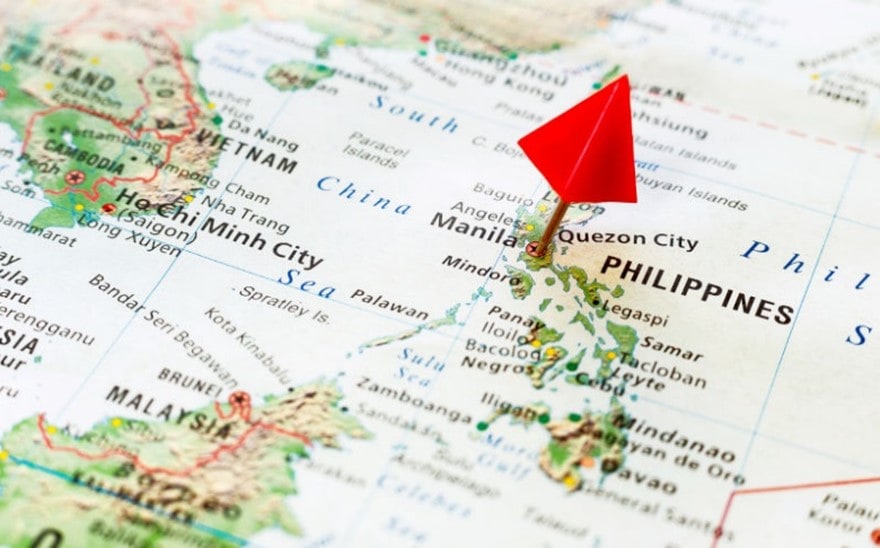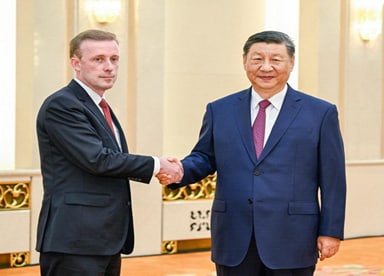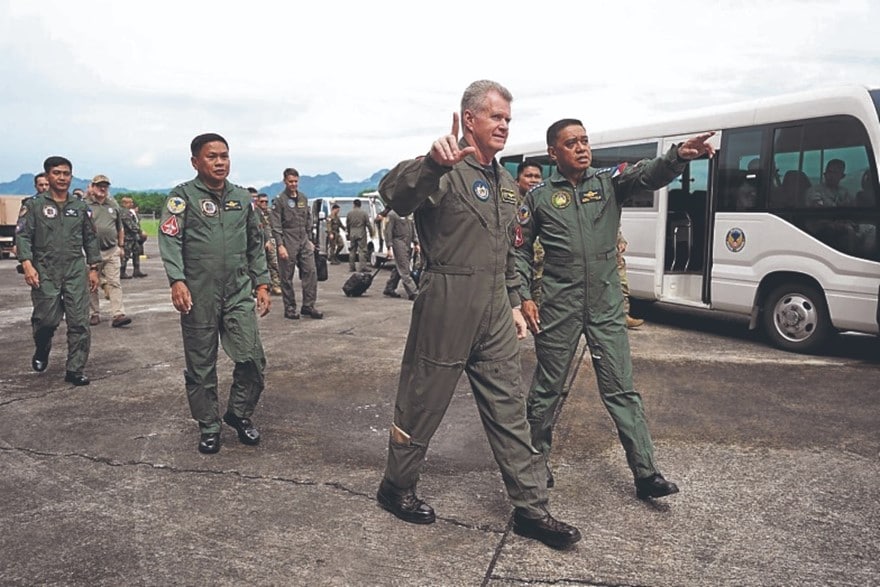Tensions between the Philippines and China remain high, as China continues its escalatory actions in the South China Sea. On August 31, 2024, the State Department confirmed that, in the vicinity of Sabina Shoal, a China Coast Guard vessel "deliberately collided three times" with a Philippine Coast Guard vessel "exercising its freedom of navigation in the Philippines' Exclusive Economic Zone (EEZ)," causing damage to the vessel and "jeopardizing the safety of the crew onboard."[1]
It is worth noting that China claims most of the South China Sea despite a 2016 ruling by The Hague-based Permanent Court of Arbitration, which stated that Beijing's claims had no legal basis. China considers the Sabina Shoal to be part of its nine-dash line claim to the South China Sea. China's new map also revives the use of a "10-dash" line – with an additional dash to the east of Taiwan.[2]
Renowned Filipino expert Richard Javad Heydarian wondered whether the Sabina Shoal will "be the trigger point for US intervention in the escalating China-Philippine clashes."[3] The recent stand-offs in the Sabina Shoal sparked a further debate on which strategy the Philippines and the United States should pursue in the South China Sea to deter China.[4]

(Source: X)
"Biggest-Ever Presence Of Chinese Ships And Warships" In The West Philippine Sea
From August 27 to September 2, a total of 203 ships from the China Coast Guard (CCG) and Chinese maritime militia (CMM) as well as Chinese warships were recorded in the West Philippine Sea. The Philippine's Rear Admiral Roy Vincent Trinidad, who is the country's navy spokesperson for the West Philippine Sea, said that this is the "biggest-ever presence of Chinese ships and warships" in the area, since the Philippine Navy began publishing its weekly tallies. "Nevertheless, the increase in numbers will not justify their illegal presence, their coercive and aggressive actions and their deceptive narratives," Trinidad further stated.[5]
Recently, Philippine Secretary of Defense Gilberto Teodoro Jr. asserted that China is the biggest disruptor of international peace in Asia. He then added that the solution to this problem is "stronger collective multilateral action" against China.[6]
Chinese Media Outlet: China's "Tolerance Is Not Infinite"
Meanwhile, China continues to threaten the Philippines through its state officials and state-controlled media, declaring that China's "tolerance" toward Manila is not "infinite." "Although China has shown restraint, its tolerance is not infinite. The Philippines should not underestimate China's resolve to protect its territory and sovereignty... Ignoring China's determination to safeguard its sovereignty will only bring disgrace to the provocateur itself. China-Philippine relations are certainly at a critical crossroads. The Philippine government should reconsider its actions in the South China Sea, as they could endanger cooperation across various fields and lead to unpredictable consequences," Chinese media outlet Xinhua wrote.[7]
Meanwhile, the Chinese media outlet Global Times stressed that, during the concluded three-day visit of US National Security Advisor Jake Sullivan,[8] China has made very clear its position on the South China Sea issue: "The US must not use bilateral treaties as an excuse to undermine China's sovereignty and territorial integrity and must not support or condone any infringement by the Philippines." "This is a warning to the U.S., but also a piece of friendly advice. To truly listen to and understand China's words, and to meet China halfway, is what the US must do to avoid 'the situation that neither China nor the US wants to see,'" the Global Times reported.[9]

Chinese President Xi Jinping met with U.S. National Security Advisor Jake Sullivan on August 29, 2024 (Source: Mfa.gov.cn)
Call To Review The MDT Between The Philippines And The United States
Philippines Ambassador to the United States, Ambassador B. Romualdez, recently reminded how the Manila-Washington relations are being strengthened: "In terms of military assistance from the United States, the Philippines received $1.14 billion worth of aircraft, armored vehicles and other military equipment from 2015 to 2022, with the amount inclusive of over $475 million in military financing – one of the biggest in Southeast Asia. Additionally, the US recently committed $500 million in military funding to enhance the external defense capabilities of the Armed Forces of the Philippines (AFP) and the Philippine Coast Guard."[10]
It is also worth noting that, on August 28, 2024, the Philippine Navy's Rear Admiral Alexandar Lopez has called to review the Mutual Defense Treaty (MDT) signed with the United States in 1951. According to Lopez, the treaty is "old and may require updating for the benefit of the parties concerned." The treaty obliges Washington to defend Manila in case of an armed attack against its ships and aircraft. Lopez's remarks came after Philippine Defense Secretary Gilberto Teodoro stated that the MDT should be interpreted more broadly for a "dynamic and cunning adversary."[11] Lopez also said the review of the MDT is needed so it can adapt to new security challenges in Philippine waters.[12]
Filipino expert Richard Javad Heydarian further explained that the Philippines are growing frustrated.[13] Philippines Defense Secretary Teordoro stated international call-outs are "not enough" to deter China.[14] For this reason, as reported by Heydarian, during a recent visit to the Philippines (from August 26-30, 2024),[15] US INDOPACOM commander Samuel Paparo stated: "We certainly have prepared a range of options and USINDOPACOM stands ready, if so called, after consultations in accordance with the treaty to execute those shoulder to shoulder with our ally."[16] He stated that those U.S. military options would allow "the potential adversary" to "build a countermeasure to those."[17]

US INDOPACOM commander Samuel Paparo and Philippines chief Gen. Romero Brawner Jr (Source: X)

Armed Forces of the Philippines chief Gen. Romeo Brawner Jr. gives US Indo-Pacific Command chief Gen. Samuel Paparo a tour of Basa Air Base in Floridablanca, Pampanga, one of the nine sites covered by the Enhanced Defense Cooperation Agreement between Manila and Washington. (Source: Armed Forces of the Philippines)
US INDOPACOM commander Samuel Paparo held a joint press conference with Armed Forces of the Philippines chief Gen. Romero Brawner Jr., who stressed that the Philippines will seek the United States' help in its resupply missions to the West Philippine Sea when its troops "don't have any supplies anymore because our resupply mission have been blocked and they are on the verge of dying."[18]
"Philippines' Armed Forces Can Manage A Hands-On To China's Aggression And Gray Zone Tactics"
Filipino security expert Chester Cabalza, president and founder of the Manila-based think tank International Development and Security Cooperation, said that the Philippines is trying to "de-escalate the situation while projecting a self-reliant tack by not acquiescing to a joint Rore [rotation and reprovisioning] with Washington."
"We are sending a message to China that the Philippines can stand on its own defense posture and our maritime entitlements and national sovereignty should be protected and safeguarded by our own navy and coast guard," Cabalza said, "this de-escalatory move is a primordial effort in the Philippines that support from allies and partners would be the last resort," Cabalza stated to the Filipino media outlet The Enquirer. "In a plight for fortitude and deterrence, Philippines' armed forces can manage a hands-on to China's aggression and gray zone tactics."[19]
Meanwhile, on September 4, 2024, Philippine Secretary of Defense Gilberto Teodoro Jr. and Secretary of Defense Lloyd Austin III had a conference call. The Philippines Department of National Defense said that this is the eighth time the two defense chiefs "spoke on the phone to discuss security developments in the Indo-Pacific region and explore ways to further enhance the Philippine-US alliance."[20]
*Anna Mahjar-Barducci is a Senior Research Fellow at MEMRI.
[1] State.gov/u-s-support-for-the-philippines-in-the-south-china-sea-12/, August 31, 2024.
[2] Rappler.com/newsbreak/fact-check/united-states-philippines-did-not-destroy-chinese-ship-escoda-shoal/, July 11, 2024.
[3] Asiatimes.com/2024/09/calls-mount-in-philippines-for-us-to-counter-china-at-sea/, September 3, 2024.
[4] Scmp.com/week-asia/politics/article/3277527/south-china-sea-how-should-philippines-respond-chinas-sabina-shoal-moves, September 7, 2024.
[5] Inquirer.net/412603/ph-navy-logs-largest-presence-of-chinese-ships-in-west-philippine-sea/#ixzz8kkfoNUMs, September 3, 2024.
[6] See MEMRI TV clip No. 11368, Philippine Secretary Of Defense Gilberto Teodoro Jr.: China Is The Biggest Disruptor Of Peace In The Region, August 28, 2024.
[7] English.news.cn/20240830/d9d0ad3ceacb48428fac05a5338a2d3b/c.html, August 30, 2024.
[8] Whitehouse.gov/briefing-room/statements-releases/2024/08/29/readout-of-national-security-advisor-jake-sullivans-meeting-with-president-xi-jinping-of-the-peoples-republic-of-china/, August 29, 2024.
[9] Globaltimes.cn/page/202409/1319056.shtml, September 2, 2024.
[10] Philstar.com/opinion/2024/09/01/2381948/right-not-might-will-ultimately-prevail, September 1, 2024.
[11] Nhk.or.jp/nhkworld/en/news/20240829_34/, August 29, 2024.
[12] Mirror.pco.gov.ph/news_releases/review-of-the-mutual-defense-treaty-with-the-us-pushed/, UAgust 28, 2023.
[13] Asiatimes.com/2024/09/calls-mount-in-philippines-for-us-to-counter-china-at-sea/, September 3, 2024.
[14] Rappler.com/newsbreak/inside-track/gibo-teodoro-wish-united-nations-security-council-issue-resolution-china/, August 28, 2024.
[15] Pacom.mil/Media/News/News-Article-View/Article/3891058/us-indo-pacific-commander-visits-the-philippines-for-milops-mdb-seb/, August 30, 2024.
[16] Asiatimes.com/2024/09/calls-mount-in-philippines-for-us-to-counter-china-at-sea/, September 3, 2024.
[17] Asiatimes.com/2024/09/calls-mount-in-philippines-for-us-to-counter-china-at-sea/, September 3, 2024.
[18] Rappler.com/philippines/manila-tap-united-states-help-troops-on-verge-death-west-sea/, August 29, 2024.
[19] Inquirer.net/412112/brawner-happy-about-us-offer-to-aid-in-west-philippine-sea-resupply-ops-but-we-will-depend-on-ourselves-first/, August 29, 2024.
[20] Pna.gov.ph/articles/1232758, September 6, 2024.




